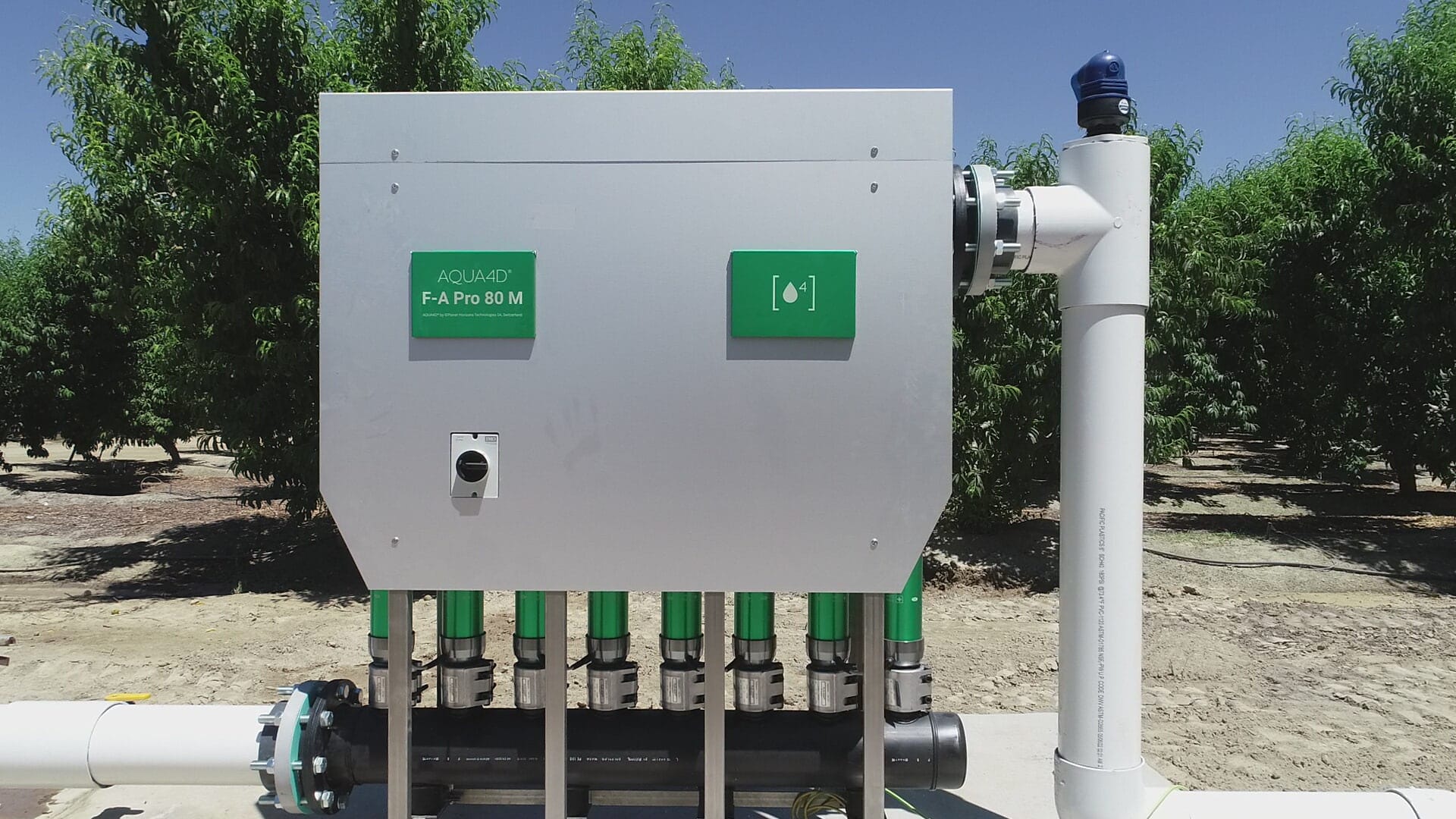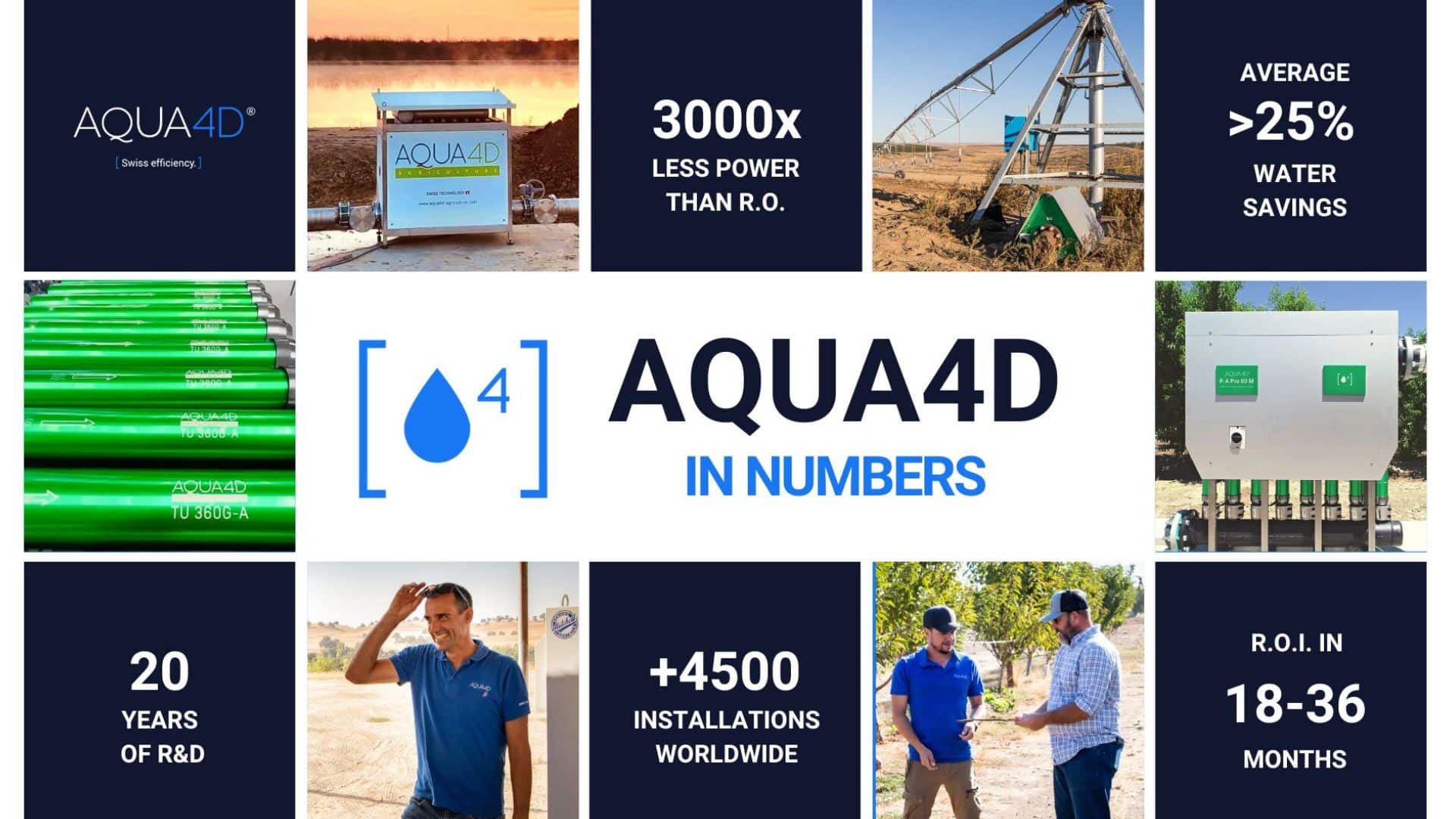Despite its importance for national food security, Californian agriculture is currently facing a perfect storm: dwindling water supplies and land degradation. Not only this, but faced with squeezed bottom lines and resources, farmers are still over-irrigating and over-fertilizing – detrimental both to their crops and the long-term viability of their business.
Through innovative water treatment and a Technology-as-a-Service model, AQUA4D® simultaneously addresses these major issues to get the most existing out of water infrastructure. At the same time, this Precision Irrigation entails less pumping, reduced energy use, and reduced application of chemicals and fertilizers. This regenerative and sustainable approach to agriculture results in healthier lands, saved resources and labor, with increased food & water security to feed a growing population.
Outcome 1: Saving water through precision irrigation
AQUA4D® promotes water penetration into soil micropores and improves water retention in the rhizosphere regardless of soil type. Years of practical experience have shown that it is possible to save on average 25% irrigation water. Furthermore, with a Technology-as-a-Service (TaaS) concept our agronomists work with farmers on strict monitoring protocols to recommend further irrigation reductions. In combination, this can sometimes result in savings of 50% or more, as was the case in early 2023 at Windmill Nursery LLC.
An AQUA4D® Pro-M system at a large fruit grower in the Central Valley
This is a new paradigm of sustainable water management – improving water penetration in soil to enable an average of 25% irrigation savings (even more when combined with other Ag 4.0 technologies). This would in turn mean 25% less water withdrawals – precious resources which can then be used elsewhere and aquifers will be recharged. Lastly, and crucially, as AQUA4D® transforms poor quality and high-EC water, more better-quality potable water is available.
In the words of Richard Gemperle, an almond grower in the Central Valley, “Irrigators are saying there are completely different dynamics going on: we’ve seen an astonishing difference in our water penetration.”
Outcome 2: Saving energy and emissions through reduced pumping
While the urgent infrastructure updates are being addressed at a higher level, there is a pressing need right now to reduce power & water consumption on farms with exponentially rising energy costs. These two are inextricably linked, due to the increased energy required for pumping water ever further. Hence improving water efficiency can in turn drastically reduce power consumption.
Let’s look at the numbers. Depending on the situation, the baseline energy consumption by a pump is around 900 Wh per 1 m3. With AQUA4D® we generally observe 25% water savings, representing 180 Wh/m3, or an estimated 2880 kWh/ha savings – reducing water bills while conserving a precious resource.
Depending on the situation, the baseline energy consumption by a pump is around 900 Wh per 1 m3. With AQUA4D® we generally observe 25% water savings, representing 180 Wh/m3, or an estimated 2880 kWh/ha savings – reducing water bills while conserving a precious resource.
Furthermore, for salinity management, use of AQUA4D® negates the implementation of costly solutions such as reverse osmosis (RO). As average RO energy consumption is at least 2000 Wh per 1 m3 and only 1 Wh with AQUA4D®, this uses 2000x less electricity, or even 3000x less as was the case in a recent study in Latin America.
Outcome 3: Saving labor and resources
From a farmer’s perspective, the changes to water management practices brought about by AQUA4D® have a direct impact on their own resources and labor expenditure.
The new Ag 4.0 approach to farm management keeps an eye on their irrigation needs, in many cases reducing the need to physically travel to turn on watering systems. Moreover, due to the leaching effect of AQUA4D®, the water- and labor-intensive washing of soils is required, chemicals no longer need to be applied. At the same time, NPK use can be significantly optimized – simultaneously saving labor and input costs.
Last but not least, the AQUA4D® effect on minerals mean drippers and pipes no longer clog with limescale, biofilm, or corrosion. In the words of a farmer in France, “We needed 6 people to work on the maintenance of the drippers. In the month following AQUA4D® installation, these 6 people could start working on something else instead.” Coupled with reduced maintenance needs, the lifecycle and efficiency of irrigation systems in general is lengthened.
“Return on Investment happens from both more and less.” says agronomy manager Jeff Nunes. “Water usage goes down because the soil stays moister for longer, and fertilizers are more efficiently dissolved. But equally, time, resources and money are saved which goes right into the farmer’s pocket. This also cuts back on labor too, thus decreasing spending on fertilizers, water, and manpower. For me, this too is part of the dawn of a new agricultural era.”
California
Water-Smart Agriculture
Precision Irrigation
“Water usage goes down because the soil stays moister for longer, and fertilizers are more efficiently dissolved. In turn, this also cuts back on labor, thus decreasing spending on fertilizers, water, and manpower. For me, this is part of the dawn of a new agricultural era.”
– Jeff Nunes, Agronomy Manager, California





